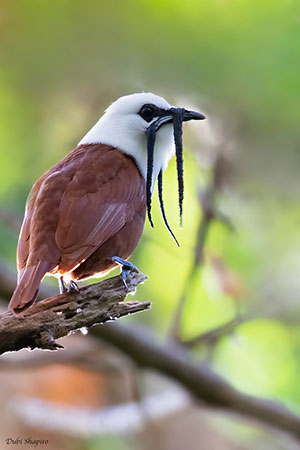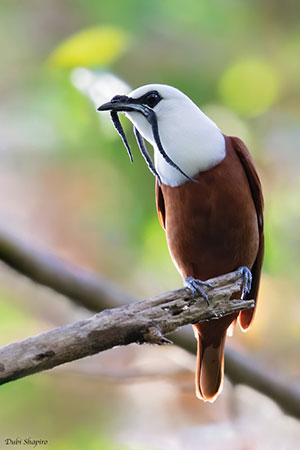
Fr: Araponga tricaronculé
Ang: Three-wattled Bellbird
All: Dreilappenkotinga
Esp: Campanero Tricarunculado
Ita: Campanaro caruncolato
Nd: Drielelklokvogel
Sd: tretömmad klockkotinga
Photographer:
Dubi Shapiro
Dubi Shapiro Photo Galleries
Text by Nicole Bouglouan
Sources:
HANDBOOK OF THE BIRDS OF THE WORLD Vol 9 - by Josep del Hoyo - Andrew Elliot - David Christie - Lynx Edicions - ISBN: 8487334695
Animal Diversity Web (University of Michigan Museum of Zoology)
THE WILSON JOURNAL OF ORNITHOLOGY
The bell-like call of the Three-Wattled Bell Bird
Bellbird Biological Corridor preserves habitat of the three-wattled bellbird
Wikipedia, the free encyclopaedia
Three-wattled Bellbird
Procnias tricarunculatus
Passeriformes Order – Cotingidae Family
INTRODUCTION:
The Three-wattled Bellbird is endemic to Central America where it is found from E Honduras to W Panama. It breeds at high elevation in highland areas, and performs altitudinal movements to spend the winter in lowlands.
This species feeds mainly on large fruits, especially those of Lauraceae family.
During the breeding season, the male displays from treetops by shaking the three long black wattles while calling continuously, uttering the distinctive bell-like call giving the bird its name.
Male and female have different plumages. It is very cryptic for the female, allowing her to blend into the vegetation when she is on the nest. Concerning the male, the wattles continue to grow during its whole life.
The Three-wattled Bellbird is affected by habitat loss in the wintering areas, caused by deforestation and clearance for agriculture, cattle and banana plantations.
The species is currently classified as Vulnerable.
DESCRIPTION OF THE BIRD:
Biometrics:
Length: M: 30-33 cm – F: 25 cm
Weight: M: 220 g – F: 145 g
The Three-wattled Bellbird adult male has white head, neck and breast, whereas rest of plumage is chestnut-brown.
On the white head, lores and eyelids are black. We can see three long, blackish wattles dangling from the base of the upper mandible and the two corners of the wide, black mouth. The length is about 1/3 of the body’s length.
The black bill is very wide at the gape. The cutting edges are paler grey. The eyes are blackish-brown. Legs and feet are dark grey but the pads of the toes are yellowish.

The female is very different and smaller than male. She lacks the wattles.
The upperparts are olive-green, darker on primaries and their coverts. The underparts are yellow with olive-green streaking except on the yellow vent.
On the head, the face shows indistinct, dull yellow streaks. Both crown and nape are olive-green. We can see a yellow eyering around the dark eye.
The juvenile resembles female. The young male may acquire the plumage generally over three years. The wattles appear at 6-12 months, but they are smaller than in adult male.
RANGE:
The Three-wattled Bellbird breeds from E Honduras (Sierra de Agalta), NW Nicaragua, Costa Rica and W Panama (E to Azuero Peninsula).
It usually performs altitudinal movements to spend the winter in adjacent lowlands.
HABITAT:
The Three-wattled Bellbird breeds in the highlands in humid mountain forest, between 1,200 and 2,300 metres of elevation and occasionally higher.
Outside of breeding season, it is found in foothills and lowland forests, down to sea-level.
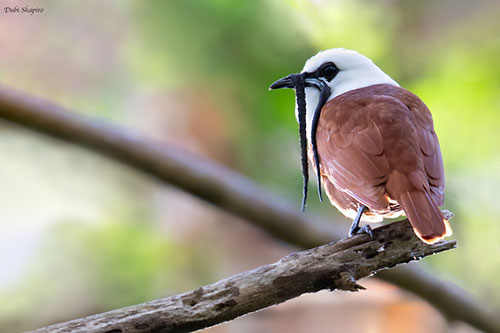
CALLS AND SONGS: SOUNDS BY XENO-CANTO
The Three-wattled Bellbird is often detected by the advertising song, a distinctive bell-like call given by the male. This sound is heard as a complex three-part song. It is described as a loud hammer-like “boing” often combined with less loud squeaks, whistles and various harsh or sharp notes. This call is among the loudest bird calls on Earth.
The call is given by the perched male with the body positioned forwards and the bill open wide. This call produces a sound of 100 decibels.
The adult male calls most of the day in the territory. It becomes very noisy when attracting females.
The dialect of the song shows marked regional variations. The song is not determined by instinct, but the bird learns its song.
BEHAVIOUR IN THE WILD:
The Three-wattled Bellbird feeds mainly on fruits of various plant species, and especially those of Lauraceae. It is able to feed on large fruits of up to 25 mm in diameter, thanks to the wide gape. It also consumes berries.
It plucks food items while perched, but also by making short aerial sallies. It plays an important role in dispersing the seeds of the fruiting trees. It forages at middle and upper levels of the mature humid forest.
During the breeding season, the Three-wattled Bellbird stays in middle to upper areas of montane forests, at 1,200 to 2,100 metres of elevation.
The males display from exposed perches at treetops, but these perches are mainly used by the males to advertise themselves by calling, giving their loud, hammer-like or bell-like calls. The territories are established around these perches and the males spend much of their time there.
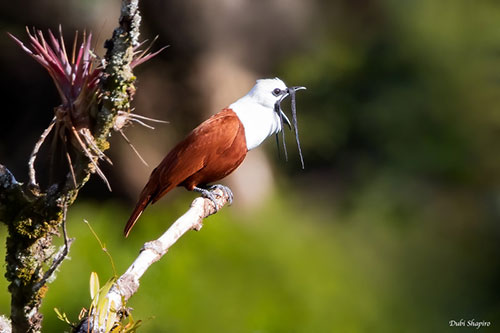
However, courting a female does not take place on these high perches. If a female is attracted by a male, it flies steeply down to reach a small tree in the understorey in the forest below. When the female follows the male and appears receptive, copulation may occur on a horizontal branch of the tree, after a series of calls and jumps by the male, ending in an explosive “bock” while leaping onto female’s back.
When the male gives these loud calls, it stretches open the huge gaping black mouth while the wattles are quivering.
This display is also used against intruders and other males. The owner of the territory approaches the intruder and calls loudly near its head to intimidate it with the large black mouth and the long quivering wattles.
The female performs alone all the nesting duties.
The Three-wattled Bellbird is an altitudinal migrant and winters in lowlands. The migration is probably closely related to availability of ripe fruit.
After breeding above 1,200 metres of elevation, it moves first to higher levels before descending to sea-level. The species has been recorded on islands off the S coast of Panama.
From a recent study, individuals from the highlands of N Costa Rica move first to lowlands in SE Nicaragua, and continue then to Pacific coastal areas of SW Costa Rica.
The Three-wattled Bellbird male exhibits more or less modifications of the flight-feathers. The outer primaries are modified. The tips of inner vanes projecting beyond the outer vanes are slightly hooked. These peculiar features have probably some function in male’s courtship display when it makes short upwards flutter.
While feeding on fruit, the bird flies back and forth between different trees and performs short aerial sallies towards a fruit to pluck it.
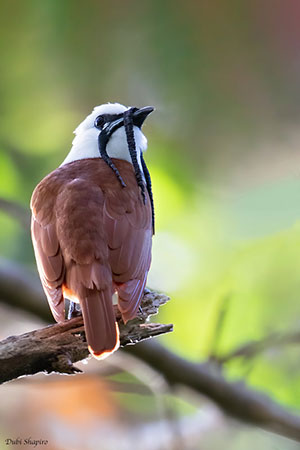
REPRODUCTION OF THIS SPECIES:
The Three-wattled Bellbird breeds in the highlands from March to September.
The female leaves her mate after courtship and copulation to build the nest and raise the chicks alone.
The nest of this species has not been studied, but we know that bellbirds are secretive nesters. The nest, usually a simple structure made of twigs, is rarely seen because it is often built and well-hidden in thick patches of vegetation. Only one or two eggs are laid per season. At this period, the nesting habitat is very important for this threatened species.
From an observation, a nest has been described in 1975. It was a structure made with loosely woven twigs of about 20 cm long. It was placed in the fork of an understorey tree, inside the canopy of the forest and at the edge of a pasture. The eggs were not found.
Comparing with birds of the same family Cotingidae, the incubation lasts 17-19 days and the nestling period was 25 to 30 days. No more information.
PROTECTION / THREATS / STATUS:
The Three-wattled Bellbird is affected by habitat loss, caused by heavy deforestation for agriculture expansion and cattle, especially in the lowlands where the birds spend the winter. Even some reserves are threatened by clearance for agriculture.
The population is roughly estimated to fall into the band 6,000/15,000 mature individuals, and it is suspected to be declining rapidly.
The Three-wattled Bellbird is currently classified as Vulnerable.
